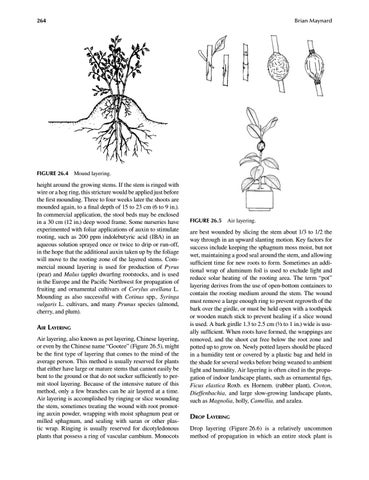264
Brian Maynard
Figure 26.4 Mound layering.
height around the growing stems. If the stem is ringed with wire or a hog ring, this stricture would be applied just before the first mounding. Three to four weeks later the shoots are mounded again, to a final depth of 15 to 23 cm (6 to 9 in.). In commercial application, the stool beds may be enclosed in a 30 cm (12 in.) deep wood frame. Some nurseries have experimented with foliar applications of auxin to stimulate rooting, such as 200 ppm indolebutyric acid (IBA) in an aqueous solution sprayed once or twice to drip or run-off, in the hope that the additional auxin taken up by the foliage will move to the rooting zone of the layered stems. Commercial mound layering is used for production of Pyrus (pear) and Malus (apple) dwarfing rootstocks, and is used in the Europe and the Pacific Northwest for propagation of fruiting and ornamental cultivars of Corylus avellana L. Mounding as also successful with Cotinus spp., Syringa vulgaris L. cultivars, and many Prunus species (almond, cherry, and plum).
Air Layering Air layering, also known as pot layering, Chinese layering, or even by the Chinese name “Gootee” (Figure 26.5), might be the first type of layering that comes to the mind of the average person. This method is usually reserved for plants that either have large or mature stems that cannot easily be bent to the ground or that do not sucker sufficiently to permit stool layering. Because of the intensive nature of this method, only a few branches can be air layered at a time. Air layering is accomplished by ringing or slice wounding the stem, sometimes treating the wound with root promoting auxin powder, wrapping with moist sphagnum peat or milled sphagnum, and sealing with saran or other plastic wrap. Ringing is usually reserved for dicotyledonous plants that possess a ring of vascular cambium. Monocots
65084.indb 264
Figure 26.5 Air layering.
are best wounded by slicing the stem about 1/3 to 1/2 the way through in an upward slanting motion. Key factors for success include keeping the sphagnum moss moist, but not wet, maintaining a good seal around the stem, and allowing sufficient time for new roots to form. Sometimes an additional wrap of aluminum foil is used to exclude light and reduce solar heating of the rooting area. The term “pot” layering derives from the use of open-bottom containers to contain the rooting medium around the stem. The wound must remove a large enough ring to prevent regrowth of the bark over the girdle, or must be held open with a toothpick or wooden match stick to prevent healing if a slice wound is used. A bark girdle 1.3 to 2.5 cm (½ to 1 in.) wide is usually sufficient. When roots have formed, the wrappings are removed, and the shoot cut free below the root zone and potted up to grow on. Newly potted layers should be placed in a humidity tent or covered by a plastic bag and held in the shade for several weeks before being weaned to ambient light and humidity. Air layering is often cited in the propagation of indoor landscape plants, such as ornamental figs, Ficus elastica Roxb. ex Hornem. (rubber plant), Croton, Dieffenbachia, and large slow-growing landscape plants, such as Magnolia, holly, Camellia, and azalea.
Drop Layering Drop layering (Figure 26.6) is a relatively uncommon method of propagation in which an entire stock plant is
4/25/08 3:31:09 PM
